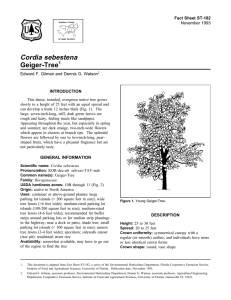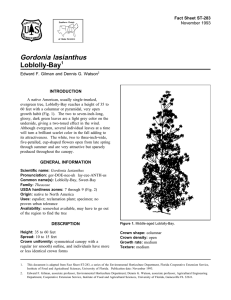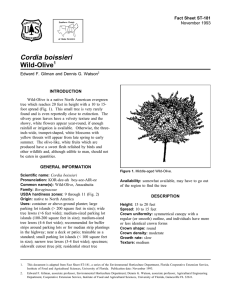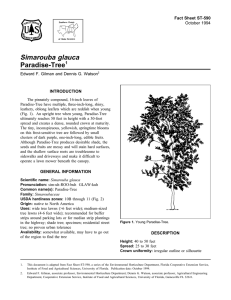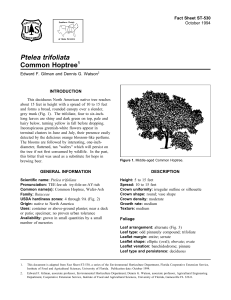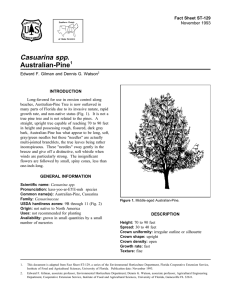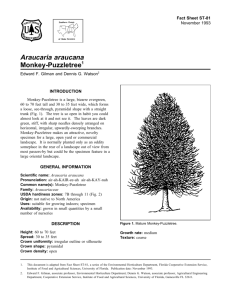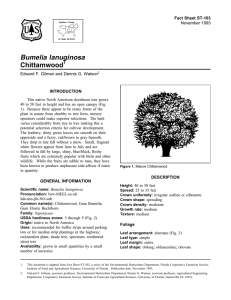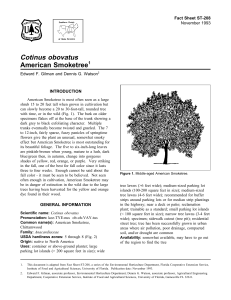Amphitecna latifolia Black-Calabash Fact Sheet ST-79 1
advertisement
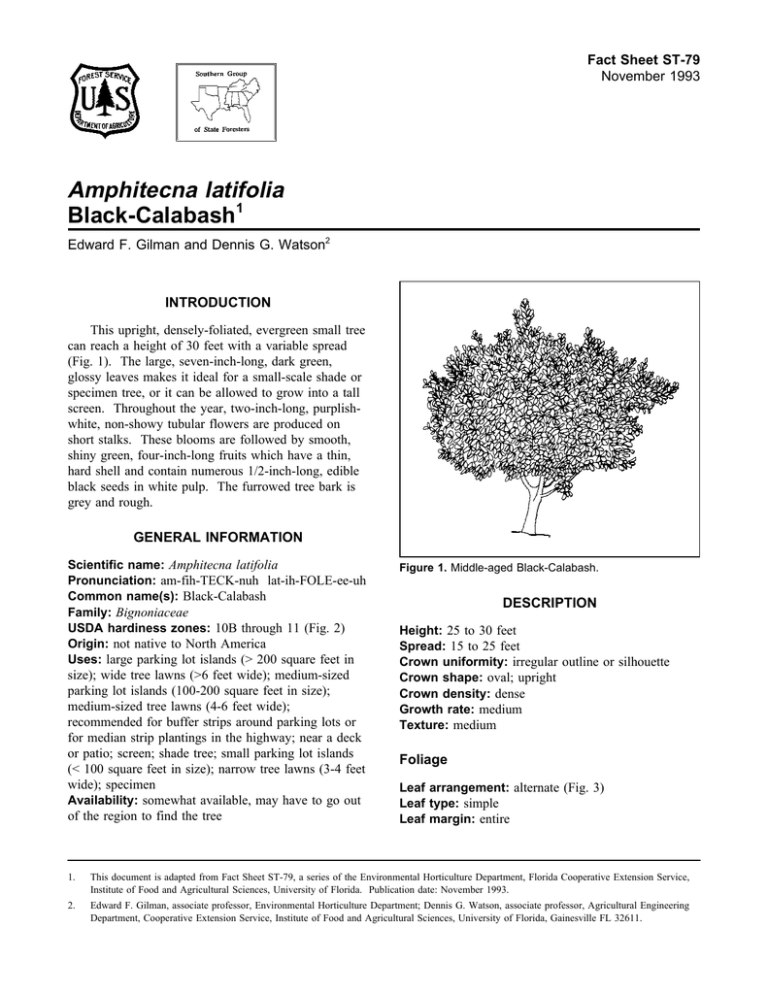
Fact Sheet ST-79 November 1993 Amphitecna latifolia Black-Calabash1 Edward F. Gilman and Dennis G. Watson2 INTRODUCTION This upright, densely-foliated, evergreen small tree can reach a height of 30 feet with a variable spread (Fig. 1). The large, seven-inch-long, dark green, glossy leaves makes it ideal for a small-scale shade or specimen tree, or it can be allowed to grow into a tall screen. Throughout the year, two-inch-long, purplishwhite, non-showy tubular flowers are produced on short stalks. These blooms are followed by smooth, shiny green, four-inch-long fruits which have a thin, hard shell and contain numerous 1/2-inch-long, edible black seeds in white pulp. The furrowed tree bark is grey and rough. GENERAL INFORMATION Scientific name: Amphitecna latifolia Pronunciation: am-fih-TECK-nuh lat-ih-FOLE-ee-uh Common name(s): Black-Calabash Family: Bignoniaceae USDA hardiness zones: 10B through 11 (Fig. 2) Origin: not native to North America Uses: large parking lot islands (> 200 square feet in size); wide tree lawns (>6 feet wide); medium-sized parking lot islands (100-200 square feet in size); medium-sized tree lawns (4-6 feet wide); recommended for buffer strips around parking lots or for median strip plantings in the highway; near a deck or patio; screen; shade tree; small parking lot islands (< 100 square feet in size); narrow tree lawns (3-4 feet wide); specimen Availability: somewhat available, may have to go out of the region to find the tree Figure 1. Middle-aged Black-Calabash. DESCRIPTION Height: 25 to 30 feet Spread: 15 to 25 feet Crown uniformity: irregular outline or silhouette Crown shape: oval; upright Crown density: dense Growth rate: medium Texture: medium Foliage Leaf arrangement: alternate (Fig. 3) Leaf type: simple Leaf margin: entire 1. This document is adapted from Fact Sheet ST-79, a series of the Environmental Horticulture Department, Florida Cooperative Extension Service, Institute of Food and Agricultural Sciences, University of Florida. Publication date: November 1993. 2. Edward F. Gilman, associate professor, Environmental Horticulture Department; Dennis G. Watson, associate professor, Agricultural Engineering Department, Cooperative Extension Service, Institute of Food and Agricultural Sciences, University of Florida, Gainesville FL 32611. Amphitecna latifolia -- Black-Calabash Page 2 Figure 2. Shaded area represents potential planting range. Leaf shape: elliptic (oval); oblong Leaf venation: banchidodrome; pinnate Leaf type and persistence: broadleaf evergreen; evergreen Leaf blade length: 4 to 8 inches Leaf color: green Fall color: no fall color change Fall characteristic: not showy Flower Flower color: purple Flower characteristics: inconspicuous and not showy; year round flowering Trunk/bark/branches: grow mostly upright and will not droop; showy trunk; should be grown with a single leader; no thorns Pruning requirement: requires pruning to develop strong structure Breakage: susceptible to breakage either at the crotch due to poor collar formation, or the wood itself is weak and tends to break Current year twig color: gray Current year twig thickness: medium; thin Culture Light requirement: tree grows in part shade/part sun; Fruit Fruit Fruit Fruit Fruit Fruit Trunk and Branches shape: round length: 3 to 6 inches covering: fleshy color: green characteristics: does not attract wildlife; suited for human consumption; inconspicuous and not showy; fruit, twigs, or foliage cause significant litter tree grows in full sun Soil tolerances: clay; loam; sand; acidic; alkaline; well-drained Drought tolerance: high Aerosol salt tolerance: high Soil salt tolerance: moderate Amphitecna latifolia -- Black-Calabash Figure 3. Foliage of Black-Calabash. Other Roots: surface roots are usually not a problem Winter interest: no special winter interest Outstanding tree: not particularly outstanding Invasive potential: little, if any, potential at this time Pest resistance: no pests are normally seen on the tree USE AND MANAGEMENT Growing in full sun or partial shade on a wide range of soils, Black Calabash has only marginal salttolerance and is very susceptible to wind damage. Top-heavy trees are known to blow over in high winds. Be sure to untangle circling or kinked roots before planting to help prevent this from occurring. Proper branch thinning can also help prevent this from occurring. Propagation is by seed, cuttings, or air-layerings. Pests and Diseases No pests or diseases are of major concern. Page 3
